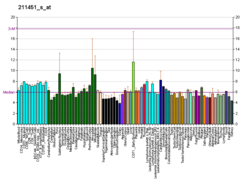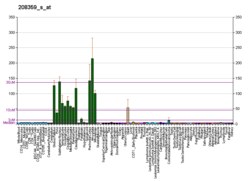From Wikipedia, the free encyclopedia
Protein-coding gene in the species Homo sapiens
Potassium inwardly-rectifying channel, subfamily J, member 4 , also known as KCNJ4 or Kir 2.3 , is a human gene .[ 5]
Several different potassium channels are known to be involved with electrical signaling in the nervous system. One class is activated by depolarization whereas a second class is not. The latter are referred to as inwardly rectifying K+ channels, and they have a greater tendency to allow potassium to flow into the cell rather than out of it. This asymmetry in potassium ion conductance plays a key role in the excitability of muscle cells and neurons. The protein encoded by this gene is an integral membrane protein and member of the inward rectifier potassium channel family. The encoded protein has a small unitary conductance compared to other members of this protein family. Two transcript variants encoding the same protein have been found for this gene.[ 5]
KCNJ4 has been shown to interact with:
^ a b c GRCh38: Ensembl release 89: ENSG00000168135 – Ensembl , May 2017^ a b c GRCm38: Ensembl release 89: ENSMUSG00000044216 – Ensembl , May 2017^ "Human PubMed Reference:" . National Center for Biotechnology Information, U.S. National Library of Medicine .^ "Mouse PubMed Reference:" . National Center for Biotechnology Information, U.S. National Library of Medicine .^ a b "Entrez Gene: KCNJ4 potassium inwardly-rectifying channel, subfamily J, member 4" .^ a b c Leonoudakis D, Conti LR, Anderson S, Radeke CM, McGuire LM, Adams ME, Froehner SC, Yates JR, Vandenberg CA (May 2004). "Protein trafficking and anchoring complexes revealed by proteomic analysis of inward rectifier potassium channel (Kir2.x)-associated proteins" . J. Biol. Chem . 279 (21): 22331–46. doi :10.1074/jbc.M400285200 PMID 15024025 . ^ a b c d Leonoudakis D, Conti LR, Radeke CM, McGuire LM, Vandenberg CA (April 2004). "A multiprotein trafficking complex composed of SAP97, CASK, Veli, and Mint1 is associated with inward rectifier Kir2 potassium channels" . J. Biol. Chem . 279 (18): 19051–63. doi :10.1074/jbc.M400284200 PMID 14960569 . ^ Leonoudakis D, Mailliard W, Wingerd K, Clegg D, Vandenberg C (March 2001). "Inward rectifier potassium channel Kir2.2 is associated with synapse-associated protein SAP97" . J. Cell Sci . 114 (Pt 5): 987–98. doi :10.1242/jcs.114.5.987 PMID 11181181 . ^ Nehring RB, Wischmeyer E, Döring F, Veh RW, Sheng M, Karschin A (January 2000). "Neuronal inwardly rectifying K(+) channels differentially couple to PDZ proteins of the PSD-95/SAP90 family" . J. Neurosci . 20 (1): 156–62. doi :10.1523/JNEUROSCI.20-01-00156.2000 PMC 6774109 PMID 10627592 . ^ Inanobe A, Fujita A, Ito M, Tomoike H, Inageda K, Kurachi Y (June 2002). "Inward rectifier K+ channel Kir2.3 is localized at the postsynaptic membrane of excitatory synapses". Am. J. Physiol., Cell Physiol . 282 (6): C1396–403. doi :10.1152/ajpcell.00615.2001 . PMID 11997254 . ^ Olsen O, Liu H, Wade JB, Merot J, Welling PA (January 2002). "Basolateral membrane expression of the Kir 2.3 channel is coordinated by PDZ interaction with Lin-7/CASK complex". Am. J. Physiol., Cell Physiol . 282 (1): C183–95. doi :10.1152/ajpcell.00249.2001 . PMID 11742811 .
Kubo Y, Adelman JP, Clapham DE, Jan LY, Karschin A, Kurachi Y, Lazdunski M, Nichols CG, Seino S, Vandenberg CA (2006). "International Union of Pharmacology. LIV. Nomenclature and molecular relationships of inwardly rectifying potassium channels". Pharmacol. Rev . 57 (4): 509–26. doi :10.1124/pr.57.4.11 . PMID 16382105 . S2CID 11588492 . Budarf ML, Périer F, Barnoski BL, Bell CJ, Vandenberg CA (1995). "Assignment of the human hippocampal inward rectifier potassium channel (HIR) gene to 22q13.1". Genomics . 26 (3): 625–9. doi :10.1016/0888-7543(95)80189-S . PMID 7607694 . Périer F, Radeke CM, Vandenberg CA (1994). "Primary structure and characterization of a small-conductance inwardly rectifying potassium channel from human hippocampus" . Proc. Natl. Acad. Sci. U.S.A . 91 (13): 6240–4. Bibcode :1994PNAS...91.6240P . doi :10.1073/pnas.91.13.6240 PMC 44174 PMID 8016146 . Tang W, Yang XC (1994). "Cloning a novel human brain inward rectifier potassium channel and its functional expression in Xenopus oocytes" . FEBS Lett . 348 (3): 239–43. doi :10.1016/0014-5793(94)00612-1 PMID 8034048 . Makhina EN, Kelly AJ, Lopatin AN, Mercer RW, Nichols CG (1994). "Cloning and expression of a novel human brain inward rectifier potassium channel" . J. Biol. Chem . 269 (32): 20468–74. doi :10.1016/S0021-9258(17)32016-1 PMID 8051145 . Cohen NA, Brenman JE, Snyder SH, Bredt DS (1996). "Binding of the inward rectifier K+ channel Kir 2.3 to PSD-95 is regulated by protein kinase A phosphorylation" . Neuron . 17 (4): 759–67. doi :10.1016/S0896-6273(00)80207-X PMID 8893032 . Cohen NA, Sha Q, Makhina EN, Lopatin AN, Linder ME, Snyder SH, Nichols CG (1997). "Inhibition of an inward rectifier potassium channel (Kir2.3) by G-protein betagamma subunits" . J. Biol. Chem . 271 (50): 32301–5. doi :10.1074/jbc.271.50.32301 PMID 8943291 . Zhu G, Qu Z, Cui N, Jiang C (1999). "Suppression of Kir2.3 activity by protein kinase C phosphorylation of the channel protein at threonine 53" . J. Biol. Chem . 274 (17): 11643–6. doi :10.1074/jbc.274.17.11643 PMID 10206975 . Kurschner C, Yuzaki M (1999). "Neuronal interleukin-16 (NIL-16): a dual function PDZ domain protein" . J. Neurosci . 19 (18): 7770–80. doi :10.1523/JNEUROSCI.19-18-07770.1999 PMC 6782450 PMID 10479680 . Dunham I, Shimizu N, Roe BA, Chissoe S, Hunt AR, Collins JE, Bruskiewich R, Beare DM, Clamp M, Smink LJ, Ainscough R, Almeida JP, Babbage A, Bagguley C, Bailey J, Barlow K, Bates KN, Beasley O, Bird CP, Blakey S, Bridgeman AM, Buck D, Burgess J, Burrill WD, O'Brien KP (1999). "The DNA sequence of human chromosome 22" . Nature . 402 (6761): 489–95. Bibcode :1999Natur.402..489D . doi :10.1038/990031 PMID 10591208 . Nehring RB, Wischmeyer E, Döring F, Veh RW, Sheng M, Karschin A (2000). "Neuronal inwardly rectifying K(+) channels differentially couple to PDZ proteins of the PSD-95/SAP90 family" . J. Neurosci . 20 (1): 156–62. doi :10.1523/JNEUROSCI.20-01-00156.2000 PMC 6774109 PMID 10627592 . Leonoudakis D, Mailliard W, Wingerd K, Clegg D, Vandenberg C (2001). "Inward rectifier potassium channel Kir2.2 is associated with synapse-associated protein SAP97" . J. Cell Sci . 114 (Pt 5): 987–98. doi :10.1242/jcs.114.5.987 PMID 11181181 . Liu Y, Liu D, Heath L, Meyers DM, Krafte DS, Wagoner PK, Silvia CP, Yu W, Curran ME (2001). "Direct activation of an inwardly rectifying potassium channel by arachidonic acid". Mol. Pharmacol . 59 (5): 1061–8. doi :10.1124/mol.59.5.1061 . PMID 11306688 . Perillan PR, Chen M, Potts EA, Simard JM (2002). "Transforming growth factor-beta 1 regulates Kir2.3 inward rectifier K+ channels via phospholipase C and protein kinase C-delta in reactive astrocytes from adult rat brain" . J. Biol. Chem . 277 (3): 1974–80. doi :10.1074/jbc.M107984200 PMID 11713246 . Olsen O, Liu H, Wade JB, Merot J, Welling PA (2002). "Basolateral membrane expression of the Kir 2.3 channel is coordinated by PDZ interaction with Lin-7/CASK complex". Am. J. Physiol., Cell Physiol . 282 (1): C183–95. doi :10.1152/ajpcell.00249.2001 . PMID 11742811 . Inanobe A, Fujita A, Ito M, Tomoike H, Inageda K, Kurachi Y (2002). "Inward rectifier K+ channel Kir2.3 is localized at the postsynaptic membrane of excitatory synapses". Am. J. Physiol., Cell Physiol . 282 (6): C1396–403. doi :10.1152/ajpcell.00615.2001 . PMID 11997254 . Preisig-Müller R, Schlichthörl G, Goerge T, Heinen S, Brüggemann A, Rajan S, Derst C, Veh RW, Daut J (2002). "Heteromerization of Kir2.x potassium channels contributes to the phenotype of Andersen's syndrome" . Proc. Natl. Acad. Sci. U.S.A . 99 (11): 7774–9. Bibcode :2002PNAS...99.7774P . doi :10.1073/pnas.102609499 PMC 124349 PMID 12032359 . Strausberg RL, Feingold EA, Grouse LH, Derge JG, Klausner RD, Collins FS, Wagner L, Shenmen CM, Schuler GD, Altschul SF, Zeeberg B, Buetow KH, Schaefer CF, Bhat NK, Hopkins RF, Jordan H, Moore T, Max SI, Wang J, Hsieh F, Diatchenko L, Marusina K, Farmer AA, Rubin GM, Hong L, Stapleton M, Soares MB, Bonaldo MF, Casavant TL, Scheetz TE, Brownstein MJ, Usdin TB, Toshiyuki S, Carninci P, Prange C, Raha SS, Loquellano NA, Peters GJ, Abramson RD, Mullahy SJ, Bosak SA, McEwan PJ, McKernan KJ, Malek JA, Gunaratne PH, Richards S, Worley KC, Hale S, Garcia AM, Gay LJ, Hulyk SW, Villalon DK, Muzny DM, Sodergren EJ, Lu X, Gibbs RA, Fahey J, Helton E, Ketteman M, Madan A, Rodrigues S, Sanchez A, Whiting M, Madan A, Young AC, Shevchenko Y, Bouffard GG, Blakesley RW, Touchman JW, Green ED, Dickson MC, Rodriguez AC, Grimwood J, Schmutz J, Myers RM, Butterfield YS, Krzywinski MI, Skalska U, Smailus DE, Schnerch A, Schein JE, Jones SJ, Marra MA (2003). "Generation and initial analysis of more than 15,000 full-length human and mouse cDNA sequences" . Proc. Natl. Acad. Sci. U.S.A . 99 (26): 16899–903. Bibcode :2002PNAS...9916899M . doi :10.1073/pnas.242603899 PMC 139241 PMID 12477932 . Leonoudakis D, Conti LR, Radeke CM, McGuire LM, Vandenberg CA (2004). "A multiprotein trafficking complex composed of SAP97, CASK, Veli, and Mint1 is associated with inward rectifier Kir2 potassium channels" . J. Biol. Chem . 279 (18): 19051–63. doi :10.1074/jbc.M400284200 PMID 14960569 . Leonoudakis D, Conti LR, Anderson S, Radeke CM, McGuire LM, Adams ME, Froehner SC, Yates JR, Vandenberg CA (2004). "Protein trafficking and anchoring complexes revealed by proteomic analysis of inward rectifier potassium channel (Kir2.x)-associated proteins" . J. Biol. Chem . 279 (21): 22331–46. doi :10.1074/jbc.M400285200 PMID 15024025 .
This article incorporates text from the United States National Library of Medicine , which is in the public domain .






